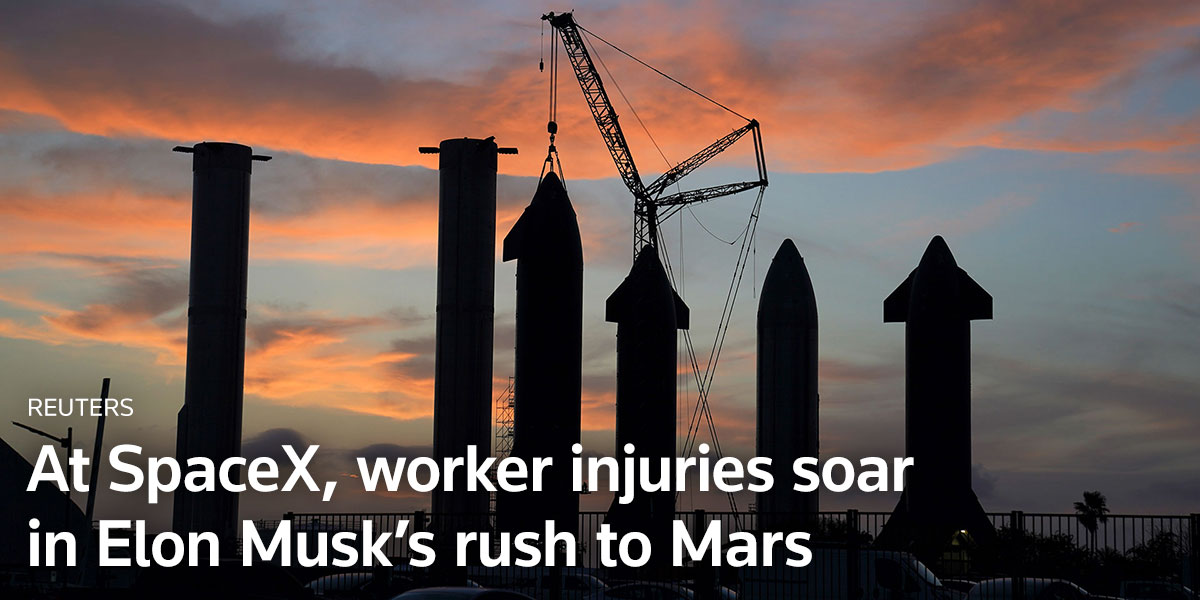At SpaceX, worker injuries soar — Reuters documented at least 600 previously unreported workplace injuries at rocket company: crushed limbs, amputations, electrocutions, head and eye wounds, and on…::Reuters documented more than 600 workplace injuries at SpaceX. Employees say they’re paying the price for Elon Musk’s push to reach Mars at breakneck speed.



Holy shit… So what does the Muskrat have to say about this?
Jesus fucking christ. This man is such a caricature of an evil capitalist villain.
Ok I’ll just inject a little bit of context into those numbers because it smells faintly of a hit piece by Reuters, simply because of the timeframe used and the number of employees spaceX has.
My experience is 30 years in the mining industry, which in that time has become pretty good at managing safety, and reporting on it.
So I’ll dig in a little.
Since 2014, so nine years.
SpaceX employee count : 13000 approximately.
Take about a quarter of that to weed out the paper pushers and company growth since 2014, gives us 3500 or so employees in the line of fire (that is, manufacturing and such).
600 reportable injuries, so about 66 injuries a year. About 5.5 a month on average, over 9 years.
Now those 3500 employees work 60 hour weeks (because: spaceX). So 5.5 injuries and 840,000 man-hours a month. I’m going to round those hours up to 1 million for convenience and to counter the fact that I ditched quite a few people in my initial assessment of SpaceX employees in the line of fire before.
And with a bit of half-assery , I say, “ta-da!” and get 5.5 reportable injuries per million man-hours at SpaceX over the last 9 years.
So, what kind of number is that? Well for tracking this kind of thing normally you would work on a value called that “lost time injury frequency rate” - LTIFR - which is the number of injuries per million hours worked. Oh look, my previous rounding to a million has become very convenient.
Looking at the data that Reuters has given, and my half-assed guesses about employees, spaceX has a long term LTIFR of 5.5. Note that number drops significantly if you use SpaceX’s entire employee base, which as a single entity, they would be quite entitled to use and report.
How does that number stand up against industry norms? 5.5 is middle of the road for manufacturing and construction, generally, but that includes all sorts of manufacturing, from building houses, to steel foundries , to making cars.
The fact that Reuters had to take 9 years of data to make the raw numbers sound alarming enough is a bad smell. They could have calculated LTIFR numbers for each year and figured out a trend and if that was alarming enough, they could have reported on it, like “SpaceX increasingly dangerous to work at!”. The fact that they didn’t makes me suspect it’s a hit piece, although I am willing to accept they didn’t want to get into LTIFR numbers and are dumbing it down for the general public.
Absolutely the number of serious injuries is a concern. Serious injuries are also at the top of a “injury pyramid”, with every layer underneath broader, all the way down to “Ow, I stubbed my toe”. If you have real figures for one layer (like a layer where an employee can’t hide an injury), you can get a good idea of what the other layers should look like.
Judging from Reuters’ numbers, the bottom “minor” layers aren’t getting reported enough, which suggests a lack of safety culture at SpaceX. Although that could simply be from Reuters’ using only public records, which, you know, only keep track of injuries worth keeping track of, so the bottom of that pyramid might only be seen by SpaceX internally.
In conclusion, the reporting by Reuters of raw numbers over long timeframes is suspect. That’s not how things are done in the safety industry, which works with weighted metrics to get results they can compare between companies. Dig in a bit further yourself.
The fact that he’s telling employees to NOT wear bright safety vests because he doesn’t like bright colors is reason enough for me to believe that safety culture at SpaceX is likely absolutely bare minimum or worse. The one employee died because he rode on top of unsecured foam insulation like a fucking idiot with multiple coworkers who encouraged it/didn’t prevent it from happening.
Is the article making it seem worse than what’s “normal” for the space manufacturing industry? I don’t know, and neither do you, as the mining industry is a hugely different environment than space manufacturing. All we have to go off is the evidence provided here, and it doesn’t look good.
If there’s other sources people can provide to shed more insight, that’d be great to get a clearer picture of what’s the normal hazard baseline here.